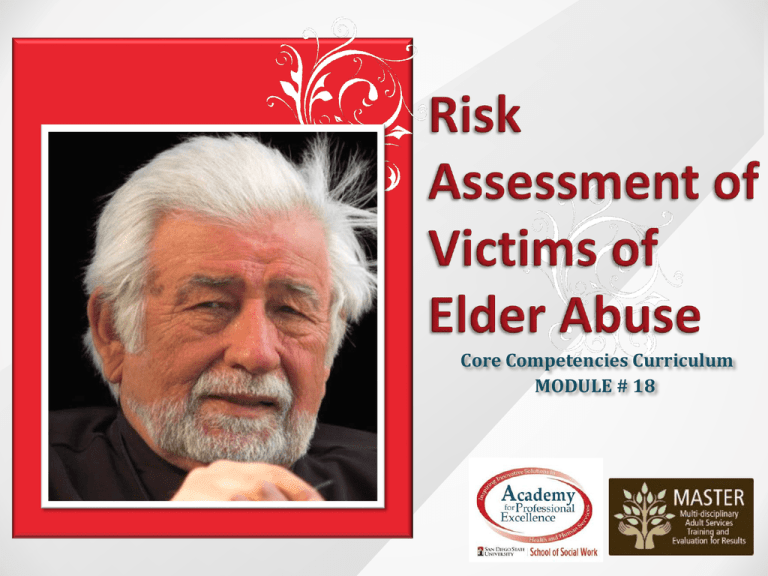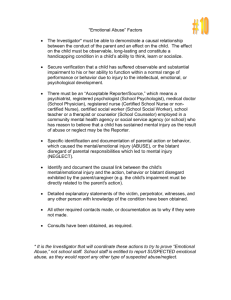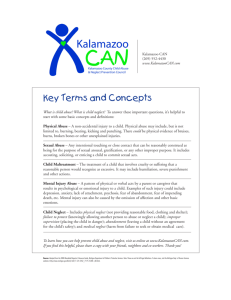PowerPoint - Academy for Professional Excellence
advertisement

Core Competencies Curriculum MODULE # 18 This training was produced by the Academy for Professional Excellence under 2009-SZ-B9-K008, awarded by the Office for Victims of Crime, Office of Justice Programs, U.S. Department of Justice. The opinions, findings, and conclusions or recommendations expressed in this training are those of the contributors and do not necessarily represent the official position or policies of the U.S. Department of Justice. The National APS Training Project is a project of the Academy for Professional Excellence, San Diego State University School of Social Work 2 Schedule for the day CEU instructions Location of restrooms Set cell phones to vibrate Introductions 3 Transfer of Learning Activity Satisfaction Survey Embedded Evaluation 4 What are the first three letters of your mother’s Smi maiden name? Alice th What are the first three letters of your mother’s Ali first name? ce Smith What are the numerals for the DAY you were born? Nov 29th Trainee ID Code S M I A L I 2 9 5 1. 2. 3. 4. 5. Define risk assessment and its function. Assess risk factors in five domains. Assess overall levels of risk in terms of severity, urgency and likelihood of harm occurring. Describe the benefits and limitations of risk assessment tools. Develop risk reduction service plans. An analysis that uses information from investigations, research, and practice experience, to: Help workers enhance clients’ safety, health, independence, and rights. Help managers optimize resources and ensuring quality, effectiveness, efficiency, and fairness. Need to make an initial determinations on safety and risk. Initial information may be incomplete or inaccurate. Increased workloads and case complexity. Need to know when interventions are likely to succeed. Plan interviews/investigations Develop plans to ensure clients’ immediate safety and reduce future risk Prioritize cases, allocate time and resources Detect changes over time Determine if interventions are successful in reducing risk Decide when to close cases Target services to those in greatest need Reduce the rate of re-referrals Increase consistency and accuracy in assessment and case management More effectively target outreach Assign cases equitably Evaluate workers’ performance Understand risk factors, patterns, trends, and clients During initial phone contact After first face to face interview At substantiation During the early stages of case planning Periodically to identify changes and new needs At case closure Levels of Risk Low, Medium, High 3 S’s of Risk: Severe Sure Soon (likely) Levels of Risk Initial assessments and emergencies Case planning Reassessments and case closure Helps workers decide: Whether/how quickly to investigate Immediate danger? (soon) Consequences if delayed? (severe) Why is the reporter calling now? Is client able to understand/make decisions? What is at risk? What, if any, immediate measures are needed? What is the likelihood that they will be harmed without intervention? (sure) Levels of Risk Low, Medium, High 3 S’s of Risk: Severe Sure Soon (likely) Levels of Risk Are protective services needed? How likely is harm or abuse? What factors indicate future harm? EVALUATE: On-going risks Risk mitigation factors Informal support systems Client’s view of the situation Factors to consider: Has risk has changed over time? What accounts for the changes? Are changes to the care plan needed? What is the likelihood that the situation will recur? Client risk of abuse/neglect is reduced or eliminated. A client with capacity requests it. Client dies or leaves jurisdiction. Other jurisdiction specific situations. Risk Indicators – observable signs that you can see or hear that indicate risk may be present. Risk Factors – conditions which put a person at risk of harm. Increases likelihood of that abuse or neglect has or will occur. Physical Behavioral Environmental Social Health and Functional status Mental Health status and capacity Financial Living environment The strongest predictor of future victimization is low social support. (Acierno, R., Hernandez, M. A., Amstadter, A. B., Resnick, H. S., Steve, K., Muzzy, W., et al. (2010). ) The experience of previous traumatic events — including interpersonal and domestic violence — increases the risk for mistreatment. (Acierno, R., Hernandez, M. A., Amstadter, A. B., Resnick, H. S., Steve, K., Muzzy, W., et al. (2010). ) Women who were threatened with a gun are 20 times more likely to be murdered. Women whose partners threatened them with murder are 15 times more likely to be killed. Choking is a high-risk indicator of eventual homicide. • Has your partner ever used a weapon against you or threatened you with a weapon? • Has he or she ever threatened to kill you or your children? • Do you think he/she might try to kill you? Client states she is afraid to tell her caregiver when she has had a toileting accident. Risk Indicator? Risk Factors? Possible Harm? Client's strengths, resiliency, and motivation Interpersonal relationships Support networks Cultural variations How clients view their situations Social Health and Functional status Mental Health status and capacity Financial Living environment Health assessments. What is the client’s health and medical status? Are they ill or injured? Functional assessments: Is the client able to perform daily tasks and meet their own needs? Help determine clients’ vulnerability and level of risk Helps workers determines what actions are needed and whether clients are able to help with planning Document behavior rather than diagnose (unless you are licensed to do so). Levels of Risk Low, Medium, High 3 Ss of Risk: Severe Sure Soon (likely) Levels of Risk Social Health and Functional status Mental Health status and capacity Financial Living environment Stroke Drug related emergencies Heart attack Heat stress and heat stroke Injuries (burns, hip fractures, head injuries) Recognize signs and symptoms Arrange for emergency care Provide information Alert medical professionals to concerns about abuse and neglect Recognize signs and symptoms Changes in mental status Role of APS in mental health emergencies Hallucinations and delusions Abrupt changes in mental status Risk factors for suicide Provide information to health care professionals Alert mental health professionals to concerns about abuse and neglect If functional or cognitive deficits are present, emergencies can happen very quickly. For example: A caregiver leaves a frail elder unattended A caregiver quits or is fired, arrested, missing, etc. Other examples? Unsafe - disrepair Unhealthy - rodents, insect infestations, human or animal waste Homeless or at risk of becoming homeless Does not meet the needs of the client. Insufficient funds to meet critical needs The offender has access to finances through a POA, contract, or checks. Pursued or courted by disreputable, unscrupulous, or opportunistic persons Result from action or inaction of others and may underlie risks associated with other domains. For example: Threats, particularly if firearms are involved. Living with someone who has been violent in the past. Left alone and unable to provide for themselves. •What is at risk (assets, independence, safety)? •What is the level of risk? (low, medium, high?) •What additional information do you need to assess Mrs. Brown’s level of risk? •What actions would you take to reduce future risk? Red = High Risk Yellow = Medium Risk Green = Low/No Risk Functional assessment tools Cognitive assessment tools Self Care tools Lethality assessment tools Trauma assessments Goals (+): Guide investigations (what to look for and what questions to ask) Develop service plans Evaluate changes over time Provide objective measures on which to compare and prioritize cases. Criticisms (-): Experts disagree about their effectiveness Time-consuming and cumbersome Interfere with client-worker rapport IDEAL protocol (Bennett Blum) Self-neglect Severity Scale (SSS)(Consortium for Research in Elder Self-Neglect of Texas) Structured Decision Making (SDM)® SHIELD Assessment Tools (Texas DFPS) APS-TRIO (Ventura County HSA) Social Health and Functional status Mental Health status and capacity Financial Living environment Goals of service plans in this domain are to reduce the risk of: Illness Accidents Neglect Dependency Abuse Goals of service plans in this domain are to reduce the risk or mitigate the impact of mental health problems. Goals of service plans in this domain are increase safety in the home. Goals of service plans in this domain are to ensure that clients have adequate resources, reduce the risk of financial loss or abuse, and secure finances that in jeopardy. Goals of service plans in this domain are to reduce the risk of abuse and neglect by others. Identify safe contacts Decide where to go in emergencies Practice how to leave safely Develop lists with phone numbers for emergency services Pack a bag Devise code words Obtain consent to contact others Does the client: Understand information that’s needed to make an informed decision? Give a plausible explanation for decisions ? Weigh the risks and benefits of options? Appreciate his/her own situation and its consequences? Communicate a choice? When risk is high and capacity is low, the APS worker should intervene, even if this means involuntary interventions. Low Capacity High Risk Involuntary Intervention When clients’ capacity is high, their decisions must be respected even if the risk is high High Capacity Any Level of Risk No Intervention without consent When clients’ capacity is in question or moderate, the level of risk needs to be taken into account. Capacity Any Level of Risk Risk Determines Intervention What type of abuse do you suspect? What is at risk? What is the level of risk (low, medium, high) Use the 3 S’s (Soon, Severe, Sure) What services or supports can be employed to reduce or eliminate the risk(s)? Stay informed! Join community forums, including multidisciplinary teams, elder abuse prevention coalitions, and task forces. Subscribe to journals, newsletters, listservs Suggest to supervisors that resources and new services be brought up at staff meetings, posted on bulletin boards, etc. Attend trainings and webinars National Adult Protective Services Association (NAPSA) napsa-now.org National Center on Elder Abuse (NCEA) ncea.aoa.gov Just a few final tasks… Post Test Training Satisfaction Survey





